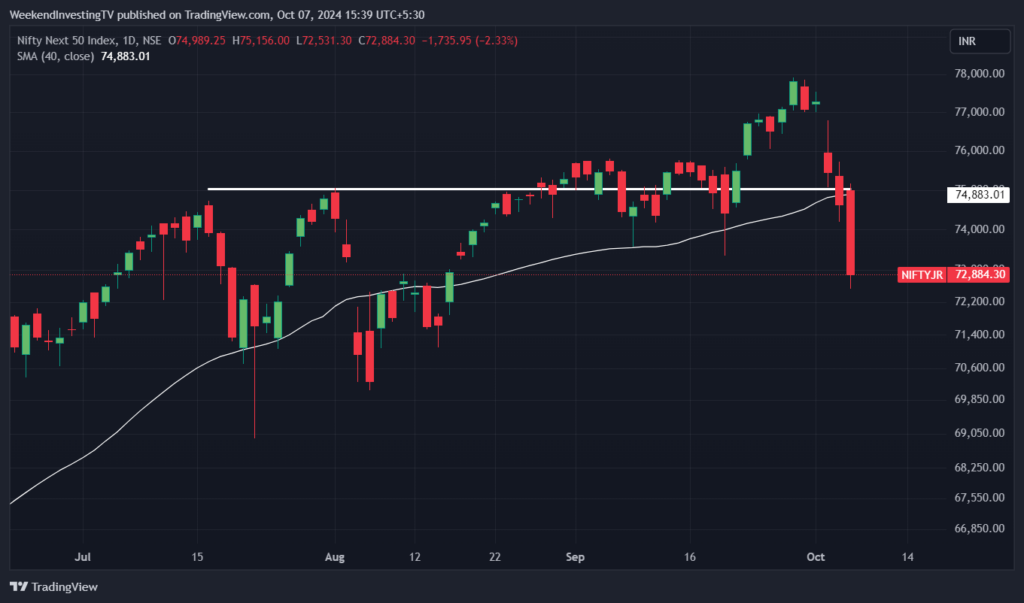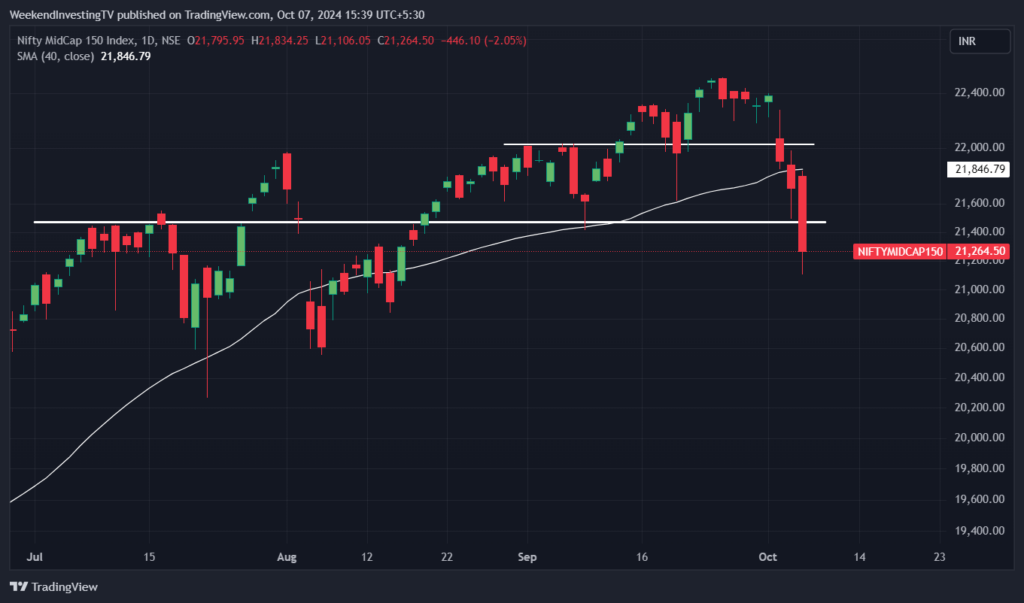
Another day that investors will not easily forget, as there was a significant amount of bloodletting in the markets. The market opened weak and remained weak throughout the session, particularly impacting small and mid-cap stocks, which were brutally thrashed—a stark change from the recent past. In previous days, when Foreign Institutional Investors (FIIs) were selling, the Nifty would move down, but mid and small caps would often hold steady. Today, however, it was the reverse: while the Nifty did decline, the small-cap universe was undeniably in a dire situation.
FIIs headline market meltdown. We will discuss how FIIs’ buying and selling have influenced the market in recent days.
Where is the market headed?
Market Overview
Over the last six days, the market has consistently moved downwards. We’ve crossed key support levels, including the SMA 40, and fallen below the mid-July peaks. In this rapid decline, we’ve come down approximately 1500 points. My sense is that we might find some support around this level, potentially forming a right shoulder in a head-and-shoulders pattern. We’ve already seen a left shoulder and a head, and while further bloodletting is a possibility, we may also consolidate here for a while before embarking on another upward leg.

Nifty Next 50
Looking at the Nifty Next 50, which had been performing better than the Nifty until now, it also faced a loss of 2.33% today. This suggests that there has been considerable selling pressure not just from foreign funds, but also from retail investors. We’ve effectively lost almost three months of gains on this index, returning to levels we first saw in July.

Nifty Mid and Small Cap
The Nifty Mid Cap also suffered today, falling over 2% and retracing back to July levels. In small caps, we saw a significant drop of 2.81% in a single session, and we’re now nearly 1000 points lower from the peak.


Nifty Bank Overview
Bank Nifty doesn’t look particularly promising either. It experienced a rapid rise before collapsing back to its starting point. This whole movement was based on the expectation that Indian rates would benefit from declining overseas rates, coupled with the idea that bond books on the balance sheets of Indian banks would help them. However, this theory seems to have fizzled out. The anticipated rate cuts in the U.S. are also now seen as unlikely, given the positive jobs data released last week, which has led to a perception that the Fed is not positioned to lower rates further.

Advanced Declined Ratio Trends
Additionally, the ongoing geopolitical tensions, particularly the conflict between Israel and Iran, along with the movement of FII funds toward Chinese markets, have contributed to a sense of despair among investors. Many are now convinced that there’s no upward momentum to look forward to. The market appears to be weighed down by these issues, leading to a lack of enthusiasm for any recovery.
There will come a point when the demand that’s been sitting on the sidelines may re-enter the market, potentially triggered by upcoming earnings results over the next week or two. However, estimates suggest these results may not provide any positive surprises. The political landscape has also been quite grim, with the outcome of the Haryana polls due tomorrow, likely resulting in a change of government. The next elections in Maharashtra don’t appear favorable for the current administration either.
These political dynamics are contributing to adjustments in the market, as investors ponder whether fringe elements may take center stage, or if the government’s current strength in numbers will remain intact following these elections.
The reasons behind the market’s behavior are varied and complex. While many factors can be ascribed, the reality is that no one truly knows for certain what will happen next. What we do know is that the current trend is extremely negative, with 445 declines compared to only 54 advances in the top 500 stocks. FII selling has been increasing; in the last four sessions alone, they have sold around 40,000 crores. While Domestic Institutional Investors (DIIs) have matched this selling with their buying, the negative sentiment stemming from FII actions heavily influences market psychology.


Nifty Heatmap
SBI, which had previously been a strong indicator, also took a significant hit today, reinforcing the notion that the market’s stability is fragile. Other major stocks like HDFC Bank and Axis Bank also experienced notable declines. Once the market begins to fall, quality or otherwise well-regarded stocks are often impacted as the demand-supply equation shifts.
Despite the downtrend, certain stocks like ITC, Bharti Airtel, Mahindra, and Infosys attempted to stabilize the Nifty to some extent. However, the Nifty Next 50 wasn’t as fortunate, with most stocks seeing losses. Notably, stocks like Varun Beverages and D-Mart, along with Siemens and DLF, were clobbered, experiencing more than 5% losses.


Sectoral Overview
Sector performance was also telling. The public sector stocks suffered greatly, with losses exceeding 3%, while the energy, commodities, and metals sectors also faced downturns of over 2%. Banking and private banking sectors saw losses of approximately 1.9% and 1.8%, respectively. Real estate, after a rough week, saw cumulative losses of about 7.2%. On a bad day like today, FMCG and pharma stocks were among the least impacted, acting as a sort of defensive buffer.

Sectors of the Day
Nifty PSU Bank Index
The public sector enterprise universe has now returned to its election day lows, indicating that continued weakness is likely if we fall below this critical point. This week’s declines mean that we’ve effectively given up eight months of gains in this sector.

Stock of the Day
Finolex Industries
Among the few bright spots, Finolex Industries performed well despite the broader market downturn, suggesting that it may have weathered the worst and could continue to rise.


Story of the Day
As of now, the Nifty is down about 6% from its peak—a rapid decline over just six sessions. Small caps have seen a similar downturn. The India VIX is rising sharply, which historically indicates increased market volatility. Crude oil prices are also a concern, having risen quickly from $69 to $79, which could further pressure Indian markets.
Despite having resorted to buying in September, FII actions seem to have reversed, leading to significant selling in October. The rupee is at the end of its range, and further FII selling could push it below the critical 84 level, which could have severe implications for the market.
In summary, October has seen about a 4% drop so far, and the ongoing political, economic, and global pressures are weighing heavily on investor sentiment. There is speculation that institutions like LIC may be pressed to buy more shares soon, especially if conditions worsen.
While we have discussed various factors that could influence the market, my own sense is that the main driver behind the current declines is the election expectations and the possibility of a change in government, which raises concerns about future stability.











